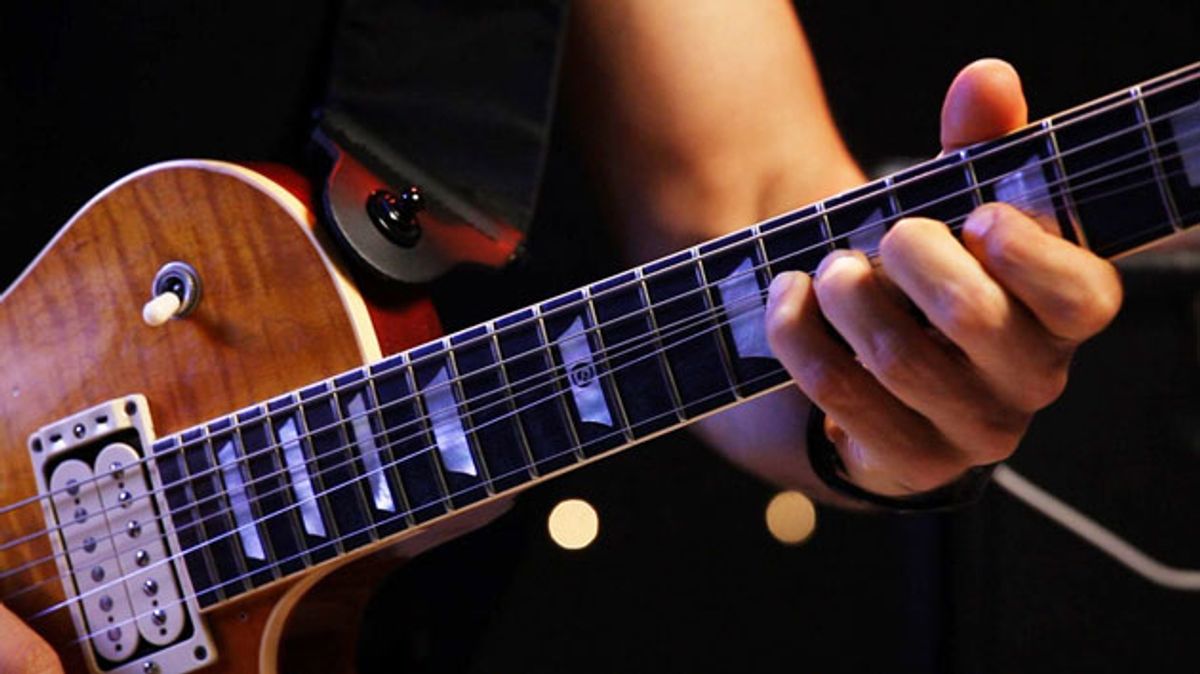Don’t sleep on one of the most unique and expressive techniques we guitarists can develop. From B.B. to Beck, everyone has their own version, and it’s about time you get a handle on yours.
Theory: Beginner
Lesson Overview:
• Increase control of your fretting hand to shape and improve your vibrato.
• From subtle intonation adjustments to wide, authoritative statements, learn different strategies for using vibrato.
• Explore ways to unlock your creative potential in any situation.
Click here to download a printable PDF of this lesson's notation.
Ask 10 guitarists what constitutes great vibrato and you’ll get 10 different answers. Because there are several different ways to vary the pitch, one size does not fit all. In the early days of guitar, the classical approach to vibrato was to create subtle pitch variations with a quick rocking motion of the fingertips. By alternately moving toward the headstock and soundhole, the player stretched the nylon string sharp and flat. It works with steel strings too. Try this: Hook up a tuner and watch how the pitch changes when you move your fingertip from left to right, perpendicular to the fret. Your finger should move with the palm, not independently. It’s a very expressive technique that can be used in a variety of situations (Ex. 1).
Click here for Ex. 1
This kind of vibrato also serves as my preferred method for a quick recovery when playing in a band, or even on a solo guitar gig, if a note or interval is not quite in tune. Considering the compromises of guitar tuning in general, I can fluctuate the pitch just enough to even out the intonation while imparting some expression.
YouTube It
During an early NPR Tiny Desk performance, classical guitarist David Russell demonstrates some extremely expressive vibrato during the first few notes of Augustin Barrios’ “Una Limosna por el Amor de Dios.”
The Blues Had a Baby
With the invention of the electric guitar and lighter strings, the shift to creating vibrato by pushing the string across the fret was a natural progression, and it remains the most widespread approach. The mechanics are simple: You apply a rotating motion to the string to slide it over the fretwire. However, the power for this back and forth motion does not come from the finger. Instead, it comes from the wrist (think of B.B. King), and less commonly, the forearm in an up-down motion (think of Eric Clapton). Your fingers simply keep the string in contact with the fret while your wrist or arm does the work.
YouTube It
Here’s a performance of Clapton’s “River of Tears” from a tour of Japan. Pay close attention to Clapton’s vibrato starting at :47. Notice how his hand just seems to float around the guitar with all the energy coming from his arm, rather than his fingers.
To gain power from the wrist, the side of your hand closest to the little finger flicks either upward or downward in a rotary motion. Directionally, the neck itself limits us to an upward motion on the 1st string and a downward motion on the 6th string. On the remaining four strings, my preference is for the direction to be consistently towards the center of the fretboard, which neatly keeps the unwound 1st, 2nd, and 3rd strings in an upward motion and the 4th, 5th, and 6th strings in a downward motion. Experiment to find what works for you.
Let It Go
In either approach, the fretting hand has a role to play in terms of tone. I find I get more power and resonance by letting go of the neck so the finger forms the sole point of contact with it. Not only does this let me control the range of vibrato—from narrow to wide—but freeing the rest of the neck to vibrate encourages an open, singing sound.
What to Avoid
Although I have greatly exaggerated the effect to make it obvious, Ex. 2 is an extreme version of what often plagues aspiring players. The vibrato is too wide and this makes things sound out of tune. And sudden speed changes with no regard for a regular rhythmic quality makes the vibrato sound ragged and uneven.
Click here for Ex. 2
Do This Instead
Exploring the full range of possibilities will lead to the greatest number of options for vibrato. An overview of just a few approaches could include:
- Fast and narrow
- Slow and narrow
- Medium speed and medium depth
- Medium speed and wide
- Fast and wide
- Any combination of the above
Left to my own devices, my tendency is to execute vibrato with medium depth and medium speed (Ex. 3).
Click here for Ex. 3
Gaining Control
Although I generally like to apply vibrato from the start, it can be effective to practice easing into it on a stationary note, as in Ex. 4. Here, I sound the note first and then begin the vibrato a moment later. This allows you to clearly hear the fundamental pitch, and then contrast it to the specific speed and depth of vibrato. Allowing a bit of space between the attack and the onset of the vibrato lets you impart a bit of variation to the note on the back half of its sustain. A great example is Carlos Santana’s solo on “Samba Pa Ti.”
Click here for Ex. 4
Once things start to feel familiar, try a subtle and narrow vibrato right from the start, as illustrated in Ex. 5. It’s there, but not quite so wide and obvious as other musical contexts might call for.
Click here for Ex. 5
Whisper or Shout?
Things don’t have to always call attention to themselves. Some vibratos may be so subtle that they are more felt than heard (especially in a track with other instruments), and it’s helpful to liken your vibrato to a sense of touch, dynamics, and sheer volume. How much attention do you want to call to a note? Generally speaking, the wider and/or faster the vibrato, the more attention it captures.
The slow and narrow approach of Ex. 6 can be especially effective when soloing over minor blues changes, contrasted by the wider approach of Ex. 7. Don’t discount how your gear choice impacts the vibe, too. On the former I played a Strat through the bright channel of a ’62 Fender Tremolux. For the latter, I ran a goldtop Les Paul through a Vox AC30 for a larger, more authoritative tone. Not surprisingly, the vibratos on the latter became not only wider, but bolder.
Click here for Ex. 6
Click here for Ex. 7
If you really want to unlock the secrets of a guitarist’s vibrato or compare it to another player’s approach, take one of your favorite guitar records and reduce the speed enough to hear exactly what’s going on. There was a time I was actively learning as many solos as I could from all three Kings, Clapton, Michael Bloomfield, SRV, and Hendrix. When I slowed the solos and riffs down enough to internalize all the subtleties, I discovered this learning experience was as effective as any guitar lesson … plus it teaches you tons about context. I love Mick Taylor’s vibrato, but it’s very different from Django Reinhardt. Using the right one at the right time is everything.
B.B.’s Hummingbird
Ex. 8 demonstrates a faster and increasingly wider vibrato that’s inspired by B.B. King. Although this one makes use of the first finger playing B on the 2nd string, 12th fret, remember to practice your vibrato with each individual finger, because sometimes you’ll fret a note with the second or third finger and want to apply some vibrato with that digit. The more flexibility you have, the better, and getting it consistent with any finger is a lifelong process.
Click here for Ex. 8
Shades of Hendrix
Another powerful tool is setting two strings into motion, and with so many beautiful vibratos on Jimi Hendrix’s Electric Ladyland album, the double-stop fourths he slides into halfway through “1983 (A Merman I Should Turn to Be)” may well have changed my life. The mechanics are the same as before: Let the wrist provide the power. Ex. 9 demonstrates a Hendrix-y kind of approach. Of course, at the end of the day, most of us play in group contexts, and it’s good to focus on how your vibrato sounds not just in a room by yourself, but in a mix with other players. So listen to your vibrato in both contexts.
Click here for Ex. 9
The Bends (Not the Radiohead Album)
Applying vibrato at the top of a bend is yet another powerful tool. Just as before, focus first on hitting your target note, then ease into the vibrato (Ex. 10). For demonstration purposes, I’ve put a vibrato on top of both bends in the example. In the real world, I’d never shake every note. With this kind of vibrato, the hand remains around the neck because the thumb is needed for strength and stability in the bend.
Click here for Ex. 10
When you’re ready to launch right into using vibrato on top of bends, as in Ex. 11, pay special attention to pitch. Deliberately overshooting to arrive just a little bit sharp allows the string to settle into perfect tuning on the release. You’ll want the pitch centered on the target note.
Click here for Ex. 11
The Vibrato Arm
Finally, with the invention of vibrato units on guitars, the vibrato bar itself became a contender. It may be used in many ways from gentle to aggressive (hello, Jeff Beck!), but for now I’ll leave you with the delicate, gentle motion. Depending on whether your bridge is floating or set flush to the body, you can pull up on the bar to raise the pitch or press down on the bar to lower it. In either case, just like before, the full range of possibilities are worth exploring. Ex. 12 has two different audio clips. One is a bit wider and more obvious. Think of them as a shimmer versus a wave. Both were played on a Strat through the brilliant channel of a ’63 AC30. The only thing that changed was the depth and pressure of my hand on the bar.
Click here for Ex. 12
Guest picker Mei Semones joins reader Jin J X and PGstaff in delving into the backgrounds behind their picking styles.
Question: What picking style have you devoted yourself to the most, and why does it work for you?
Guest Picker - Mei Semones

Mei’s latest album, Kabutomushi.
A: The picking style I’ve practiced the most is alternate picking, but the picking style I usually end up using is economy picking. Alternate feels like a dependable way to achieve evenness when practicing scales and arpeggios, but when really playing, it doesn’t make sense to articulate every note in that way, and obviously it’s not always the fastest.
Obsession: My current music-related obsession is my guitar, my PRS McCarty 594 Hollowbody II. I think it will always be an obsession for me. It’s so comfortable and light, has a lovely, warm, dynamic tone, and helps me play faster and cleaner. This guitar feels like my best friend and soulmate.
Reader of the Month - Jin J X
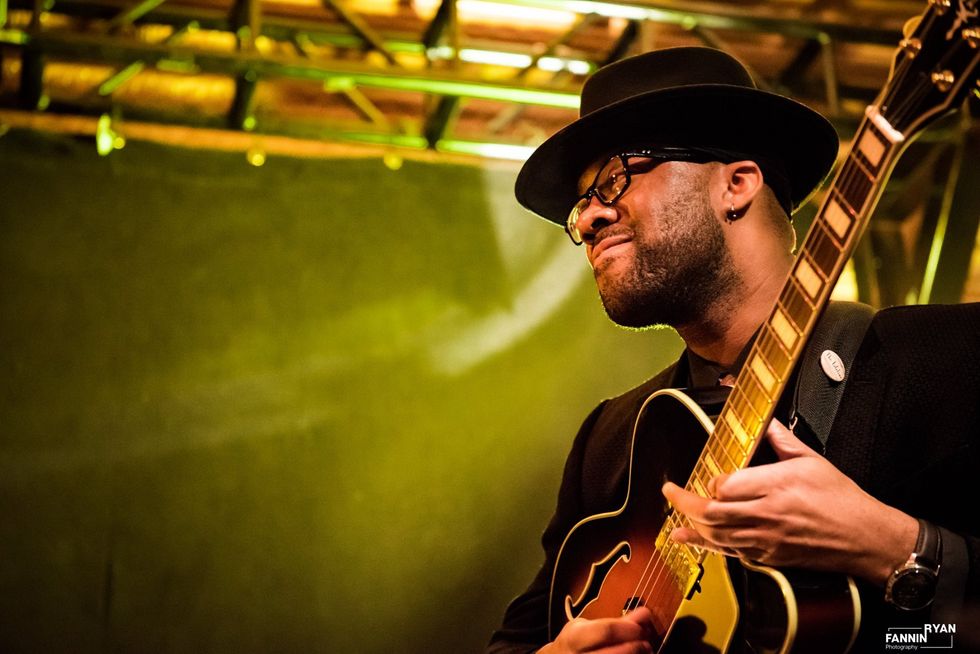
Photo by Ryan Fannin
A: For decades, the Eric Johnson-style “hybrid picking” with a Jazz III for “pianistic” voicings. Great for electric, though not so much acoustic. I’ve been recently learning to use a flatpick, à la Brian Sutton, by driving the pick “into” the string at an angle—which makes me think of Pat Metheny and George Benson, without irony.
Obsession: I’m still focused on understanding the concepts of jazz, neo-classical, and beyond, though I’m also becoming obsessed with George Van Eps’ 7-string playing, flatpicking, hip-hop beats, the Hybrid Guitars Universal 6 guitar, and the secret life of the banjo.
Editorial Director - Ted Drozdowski

A: Decades ago, under the sway of Mississippi blues artists R.L. Burnside, Junior Kimbrough, and Jessie Mae Hemphill, I switched from plectrum to fingerstyle, developing my own non-traditional approach. It’s technically wrong, but watching R.L., in particular, freestyle, I learned there is no such thing as wrong if it works.
Obsession: Busting out of my songwriting patterns. With my band Coyote Motel, and earlier groups, I’ve always encouraged my talented bandmates to play what they want in context, but brought in complete, mapped-out songs. Now, I’m bringing in sketches and we’re jamming and hammering out the arrangements and melodies together. It takes more time, but feels rewarding and fun, and is opening new territory for me.
Managing Editor - Kate Koenig

A: I have always been drawn to fingerpicking on acoustic guitar, starting with classical music and prog-rock pieces (“Mood for a Day” by Steve Howe), and moving on to ’70s baroque-folk styles, basic Travis picking, and songs like “Back to the Old House” by the Smiths. I love the intricacy of those styles, and the challenge of learning to play different rhythms across different fingers at the same time. This is definitely influenced by my classical training on piano, which came before guitar.
Obsession: Writing and producing my fifth and sixth albums. My fifth album, Creature Comforts, was recorded over the past couple months, and features a bunch of songs I wrote in 2022 that I had previously sworn to never record or release. Turns out, upon revisiting, they’re not half bad! While that one’s being wrapped, I’m trying to get music written for my sixth, for which I already have four songs done. And yes, this is a flex. 💪😎
Guitarist, songwriter and bandleader Grace Bowers will independently release her highly anticipated debut album, Wine On Venus, August 9.
The new album adds to a breakout year for Bowers, who was recently selected as a U.S. Global Music Ambassador as part of the U.S Department of State and YouTube’s Global Music Diplomacy Initiative, is nominated for Instrumentalist of the Year at the 2024 Americana Music Association Honors & Awards and will make her debut performance on the legendary Grand Ole Opry on her eighteenth birthday, July 30, 2024. Other performances this year include shows supporting Slash, The Red Clay Strays and Brothers Osborne as well as stops at Levitate Music & Arts Festival, Floyd Fest, Bristol Rhythm & Roots Reunion, Bourbon & Beyond, XPoNential Music Festival and Pilgrimage Music & Cultural Festival. See below for complete tour itinerary.
Grace Bowers & The Hodge Podge - Tell Me Why U Do That (Official Video)
Produced by John Osborne (Brothers Osborne), Wine On Venus captures the electric energy of Bowers’ live performances with The Hodge Podge. The record consists of nine soul-infused tracks including a new version of Sly and the Family Stone’s “Dance to the Music” as well as previously release single, “Tell Me Why U Do That,” of which Forbes praises, “an infectious, joyous party and a worthy introduction to Bowers.” Additionally, The Bluegrass Situation declares, “an exceptional breakout talent who seems primed for a long career to come,” while RIFF Magazine calls her “The next generation’s star of American rock, blues and funk guitar.”
Of the record, Bowers shares, “I’m so excited to share my first album with the world in August! It’s been a long time coming, and I’m proud of what was created with the incredible Hodge Podge and John Osborne producing. We recorded everything live, as it should be, for this sonic journey. I hope you love it as much as I do.”
Additionally, of the title track, she reflects, “My nana was 100 years old when she passed away last year. She would always tell me that when she died, she would be drinking wine on Venus. She was a little eccentric but thought that was just something so cool. When she passed, I wrote a song about it.”
In addition to Bowers (guitar), the record features Joshua Blaylock (keys), Brandon Combs (drums), Eric Fortaleza (bass), Esther Okai-Tetteh (vocals) and Prince Parker (guitar) as well as songwriting collaborations with respected artists such as Ben Chapman, Meg McRee, Maggie Rose and Lucie Silvas.
Originally from the Bay Area and now calling Nashville home, Bowers began garnering attention after sharing videos of herself playing guitar on social media during the pandemic. In the years since, she’s been featured on “CBS Mornings” in a piece focused on a new wave of young female guitarists, performed alongside Dolly Parton as part of her Pet Gala special on CBS, joined Lainey Wilson as part of CBS’ New Year’s Eve Live celebration, performed as part of the “Men’s Final Four Tip-Off Tailgate Presented by Nissan” and been sought after by everyone from Devon Allman to Tyler Childers and Susan Tedeshi to Kingfish. Of her 2023 Newport Folk Festival debut, Rolling Stone declared, “Her 20-minute performance gave the distinct sense that everyone lucky enough to have attended was witnessing a star in the making,” while The Tennessean calls her “a 17 year old Blues guitar prodigy,” with a, “heart as big as her talent is vast.”
Most recently this summer, Bowers performed alongside Billy Idol at the Fired Up For Summer benefit concert and raised $30,000 for MusiCares and Voices for a Safer Tennesseewith her 2nd Annual “Grace Bowers & Friends: An Evening Supporting Love, Life & Music” benefit show. With the release of Wine On Venus (distributed by The Orchard), Bowers will further establish herself as one of music’s most intriguing new artists.
For more information, please visit gracebowers.com.
Johnny Cash on the front porch of the Cash Cabin in Hendersonville, Tennessee.
Cash initially shelved the album in 1993, but now his son, John Carter Cash, has spearheaded a project to revamp and release the recordings, with the help of Marty Stuart, Dan Auerbach, Vince Gill, and other notables. Read on to get the details and see a gallery of vintage instruments and other artifacts from the Cash Cabin studio.
“The Man Comes Around” is a much-played song from the final album Johnny Cash recorded before his death in 2003, American IV: The Man Comes Around. Now, the Man in Black himself has come around again, as the voice and soul of a just-released album he initially cut in 1993, titled Songwriter.
For fans who know Cash only through his much-loved American Recordings series, this is a very different artist—healthy, vital, his signature baritone booming, his acoustic playing lively, percussive, and focused. This is the muscular Johnny Cash heard on his career-defining recordings, from his early Sun Records sides like “Cry! Cry! Cry!” and “Folsom Prison Blues” to “Ring of Fire” and “Sunday Mornin’ Comin’ Down” to later, less familiar hits like “The Baron” and “That Old Wheel.” In short, classic Cash—the performer who became an international icon and remains one 21 years after his death.
In addition to theSongwriter album, it’s also worth noting that there is a new documentary, June, that puts June Carter Cash’s life and under-sung cultural legacy in perspective. Johnny wasn’t the only giant in this family. Just the biggest one.

“I think it’s important to support my father’s legacy in the world in which we live,” says John Carter Cash, who, in addition to his own work as an artist, is the primary caretaker of his family’s estimable body of work.
I recently visited the Cash Cabin—a log cabin recording studio on the Cash family property in Hendersonville, Tennessee, that was originally built as a sanctuary where Johnny wrote songs and poetry—with PG’s video team of Chris Kies and Perry Bean—to talk about Songwriter with John Carter Cash, the son of Johnny and June Carter Cash. [Go to premierguitar.com for the full video.] In this shrine of American music, Johnny Cash recorded most of the American Recordings series, and many others, from Loretta Lynn to Jamey Johnson, have tracked here. It’s also where John Carter Cash and co-producer David “Fergie” Ferguson took apart the original Songwriter sessions and put them back together, stronger, with musical contributions by Marty Stuart, Dan Auerbach, Vince Gill, a blue ribbon rhythm team of the late bassist Dave Roe and drummer Pete Abbott, backing vocalists Ana Christina Cash and Harry Stinson, percussionist Sam Bacco, guitarists Russ Pahl, Kerry Marx, and Wesley Orbison, keyboardist Mike Rojas, and John Carter himself. Johnny’s vocals and acoustic rhythm guitar, and guest vocals by Waylon Jennings on two songs, are all that was saved from the 1993 sessions, cut at LSI studios in Nashville.
In addition to getting the lowdown on Songwriter from John Carter Cash, he showed us some of the iconic guitars—including original Johnny Cash lead guitarist Luther Perkins’ 1953 Fender Esquire and a Martin that was favored by the Man himself—that dwell at the busy private studio. [Go to the video at premierguitar.com for an eyeful.]
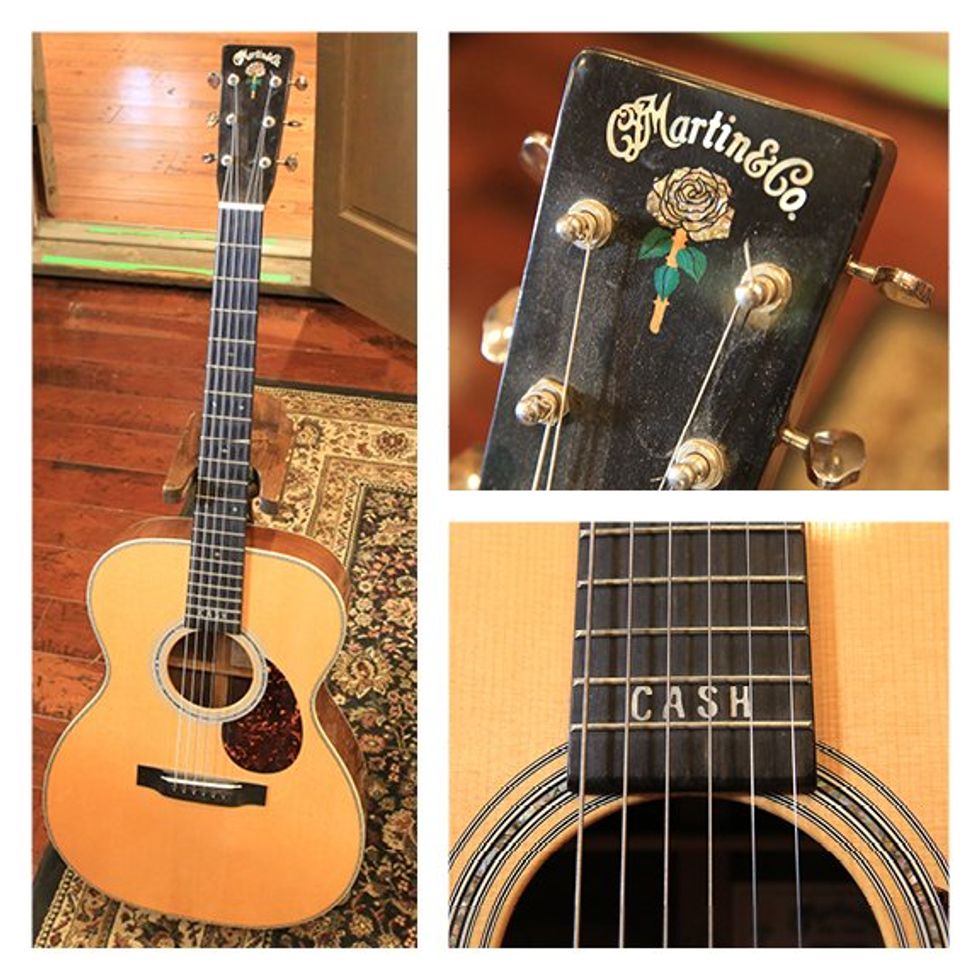
Only 44 of these Rosanne Cash signature model OM-28s were made by Martin. John Carter Cash says it’s his favorite guitar to play, and he and house engineer Trey Call attest that it’s probably the most frequently chosen instrument by guests recording in the studio.
Photos by Perry Bean
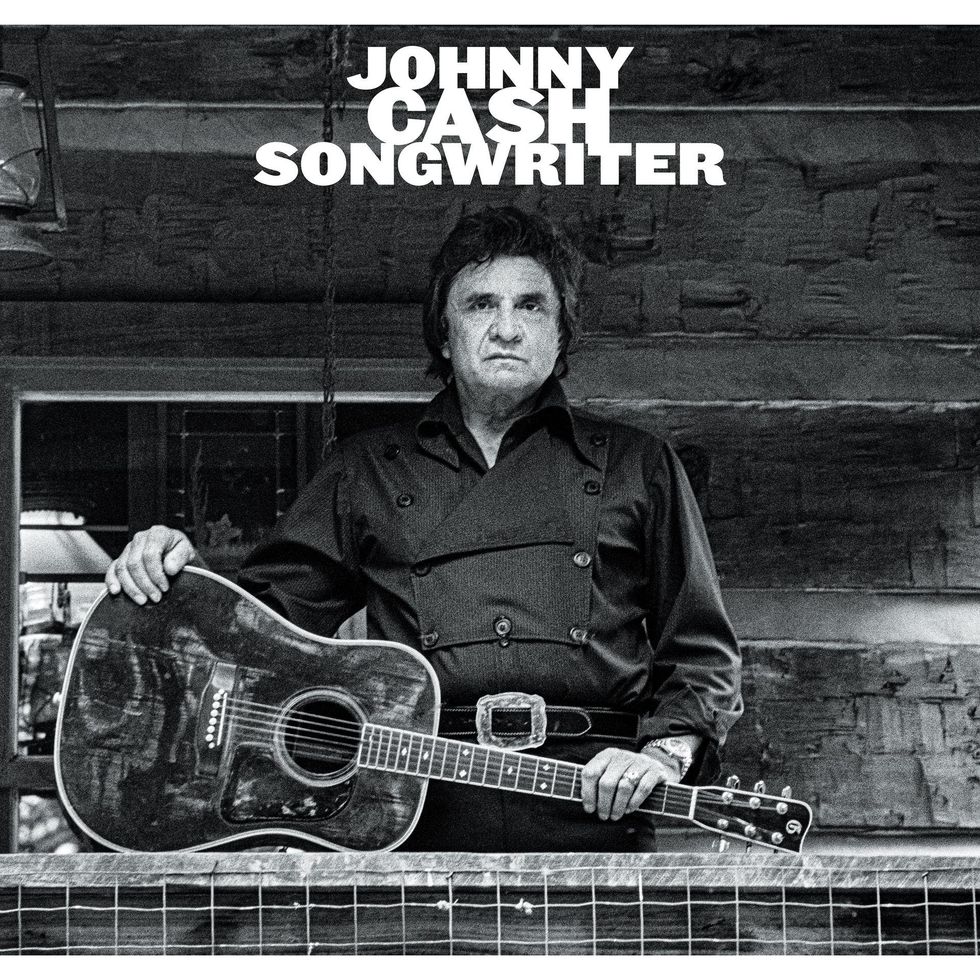
Only Johnny Cash’s original vocal and guitar tracks, and Waylon Jennings’ performances, were kept from the 1993 sessions. Marty Stuart, Vince Gill, Dave Roe, Dan Auerbach, and others contributed new tracks.
Speaking about Songwriter, John explains, “In some ways, these recordings fell through the cracks. I was in some of the sessions and can hear my guitar on some of the original recordings.” Dave Roe was also on those initial sessions, but he’d just started to play upright bass and didn’t have the finesse he lends to the revamped album.
The idea with Songwriter, John Carter relates, wasn’t to do anything more with the music than make it stronger. His dad was initially unhappy with the overall playing on the LCI recordings. “We didn’t add elements to make it about the ‘now’ or more ‘Americana’ or whatever,” he says.
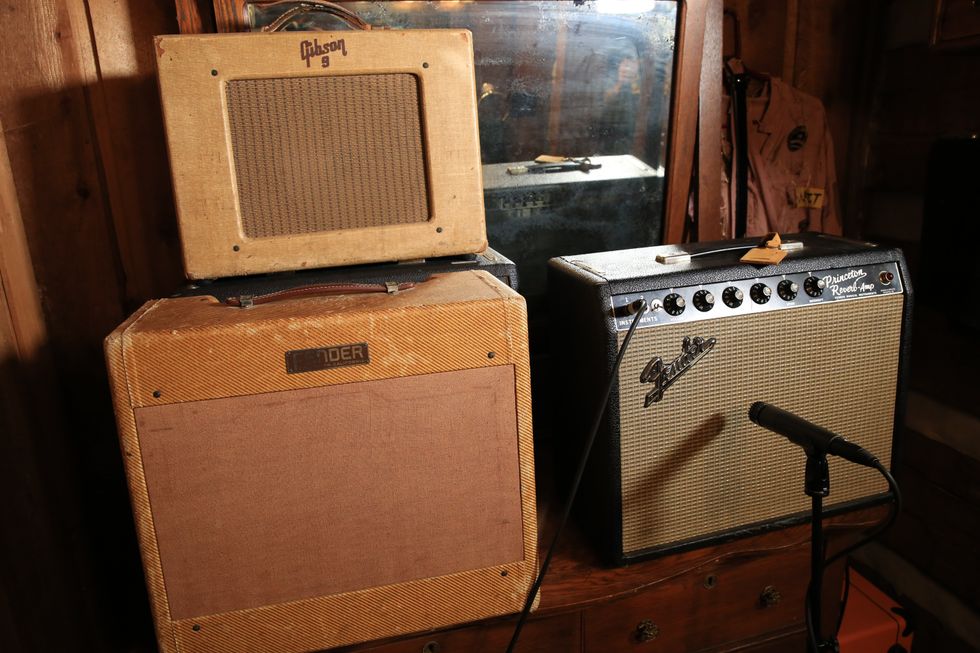
The amp room at the Cash Cabin studio has some small but potent combo treasures.
Photos by Perry Bean
Nonetheless, Songwriter does take the Cash legacy to some new places, including the realm of psychedelia. Although the song “Drive On,” about a trucker who survived the Vietnam war with internal and exterior scars, was written for the 1993 sessions, it debuted in 1994 as part of the American Recordings album. The Songwriter treatment is radically different, from the panned amp, beating with tremolo, that opens the song to the concluding lysergic odyssey of 6-string provided by John Carter and Roy Orbison’s son, Wesley. It might well appeal to Johnny, who was a musical maverick—insisting that then-controversial figures like Bob Dylan and Pete Seeger, as well as a just-emerging Joni Mitchell and Linda Ronstadt, appear on the ABC network’s The Johnny Cash Show, which aired from 1969 through 1971.
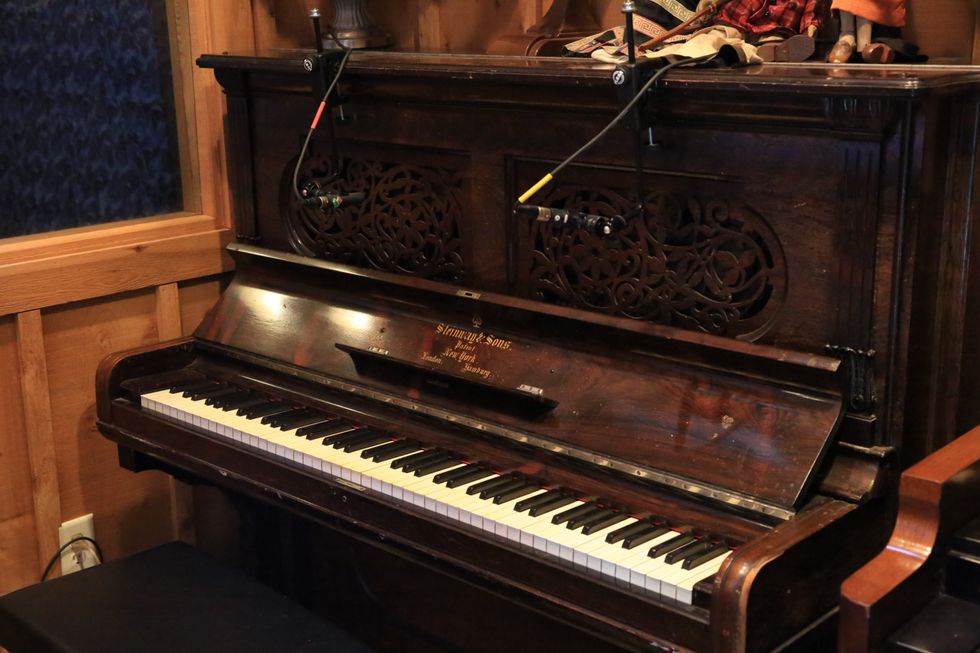
This is June Carter Cash’s piano—an antique Steinway upright that still earns its keep as one of the studio’s active instruments. Nothing in the Cabin is a museum piece.
Photos by Perry Bean
John Carter, who is a singer-songwriter and producer, and is currently at work on his own fourth solo album, notes that the sonically spacious Songwriter opener “Hello Out There” resonates with him most, emotionally, as its lyrics balance the possible end of humanity with a message of hope. But every song on the album brims with empathy and kindness in strong measure. “Like a Soldier,” which blends Johnny’s patented guitar thrum with an introspective story about his battles with addiction, and “She Sang Sweet Baby James,” about a struggling single mother singing the James Taylor song to comfort her infant, are two more examples. And the guitars are always prominent, whether they’re Russ Pahl’s steel providing ambient textures or Marty Stuart’s hard-charging country licks, which breathe fire into the album.
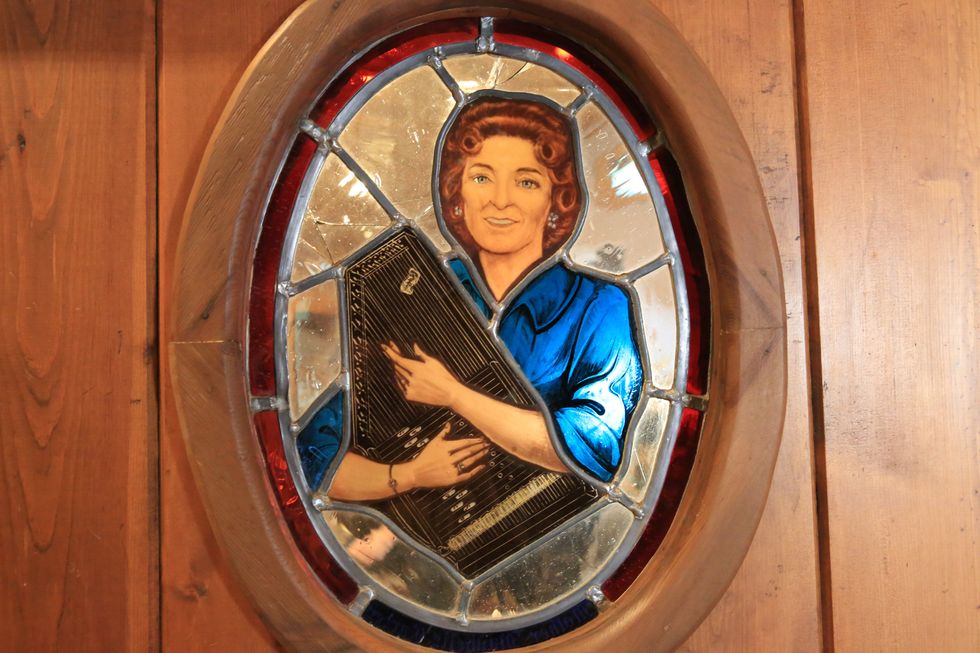
A stained-glass portrait of Mother Maybelle Carter with her autoharp. Mother Maybelle invented a style of guitar playing, where melody was executed on the bass strings and rhythm on the high strings, that influenced Chet Atkins, Merle Travis, and a host of other famed pickers.
Photos by Perry Bean
For Stuart, who toured with Johnny Cash for six years and played on many of the Man in Black’s recordings, the experience of working on the retooled Songwriter, as well as his time with the senior Cash, was “mystical—everything about him was mystical. Even after I left his band, anytime the chief called, I was available. To the day he passed away, he was the boss. So when John Carter called and said he needed guitar on some of his dad’s tracks, I went over there. It’s so natural to hear that voice in the headphones. What I always loved about playing against him is that his voice is like an oak tree. You can put anything you want next to it, and it still stands out.”
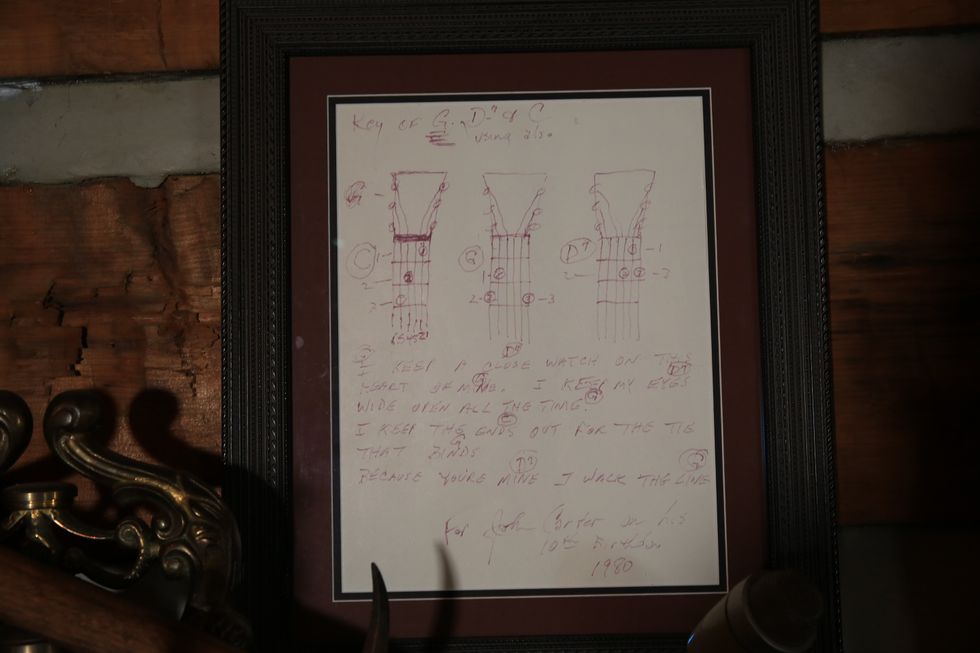
From father to son: On his 10th birthday, Johnny Cash drew John Carter Cash this chord diagram for “I Walk the Line.”
Photos by Perry Bean

The exterior of the Cash Cabin—one of the sacred places of American music and still a busy working studio.
Photos by Perry Bean
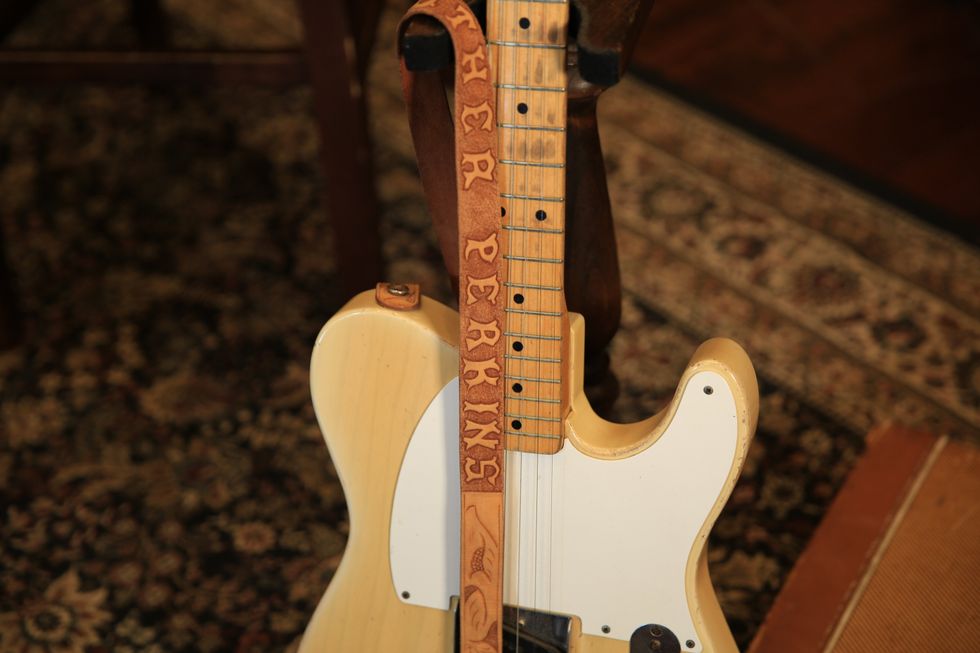
This 1953 Fender Esquire belonged to Luther Perkins, who was a member of Cash’s first recording bands and played on all of the Man in Black’s foundational recordings for Sun Records—likely with this guitar.
Photos by Perry Bean
Stuart’s instruments of choice for Songwriter were a ’50s Telecaster owned by Clarence White that bears the first B-bender, a 1939 Martin D-45 that Cash used on his ’60s/early ’70s TV show and gifted to Stuart, and a silver-panel Fender Deluxe, in addition to John Carter’s ’59 Les Paul, another of Johnny’s old Martins, and a baritone that resides at the Cabin. And Stuart’s focus was getting back to the template of Cash’s original Tennesse Two and Tennessee Three bands, and the guitar style created by Luther Perkins, Stuart’s first guitar hero. “They had their own language, and it’s a foundational sound inside of me,” he says. “With Johnny’s voice and the thumb of his right hand on the guitar as a guide, that architecture was all there. I heard the album the other day for the first time, and I thought, ‘Man, John Carter and David Ferguson worked their hearts out to honor the real sound.’”
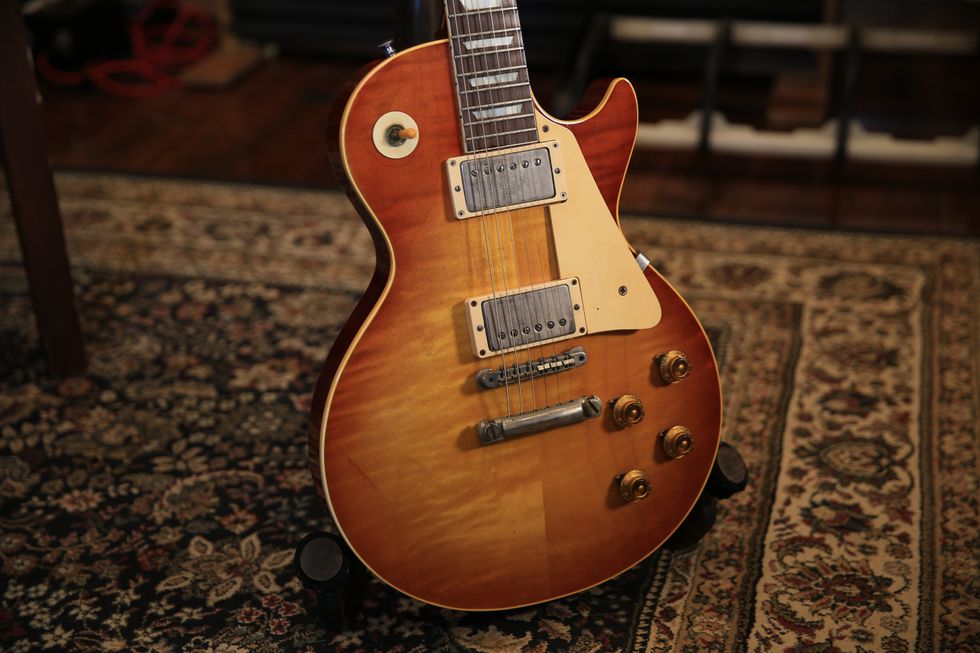
John Carter Cash bought this 1959 Gibson Les Paul at Gruhn’s in Nashville. It has a neck that is atypically slim for its vintage and appears as part of the psychedelic guitar interplay on the Songwriter song “Drive On.”
Photos by Perry Bean
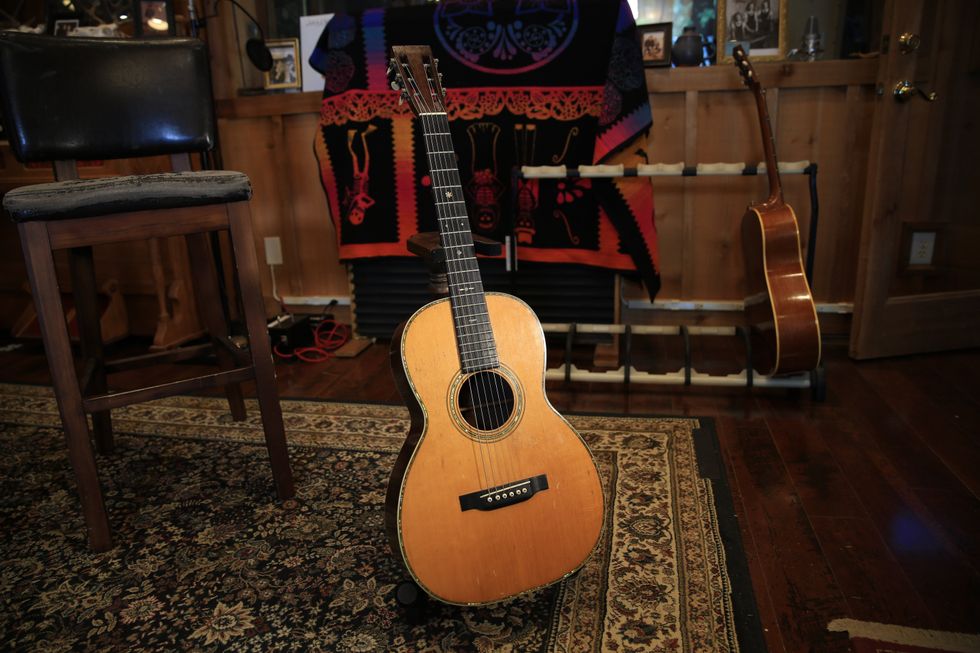
John Carter Cash remembers this Martin 40 H from his childhood as the guitar Johnny kept around the house to play on a whim or when he was chasing a song idea. The year is unknown, but as a guitar that Johnny Cash played, it is priceless.
Photos by Perry Bean
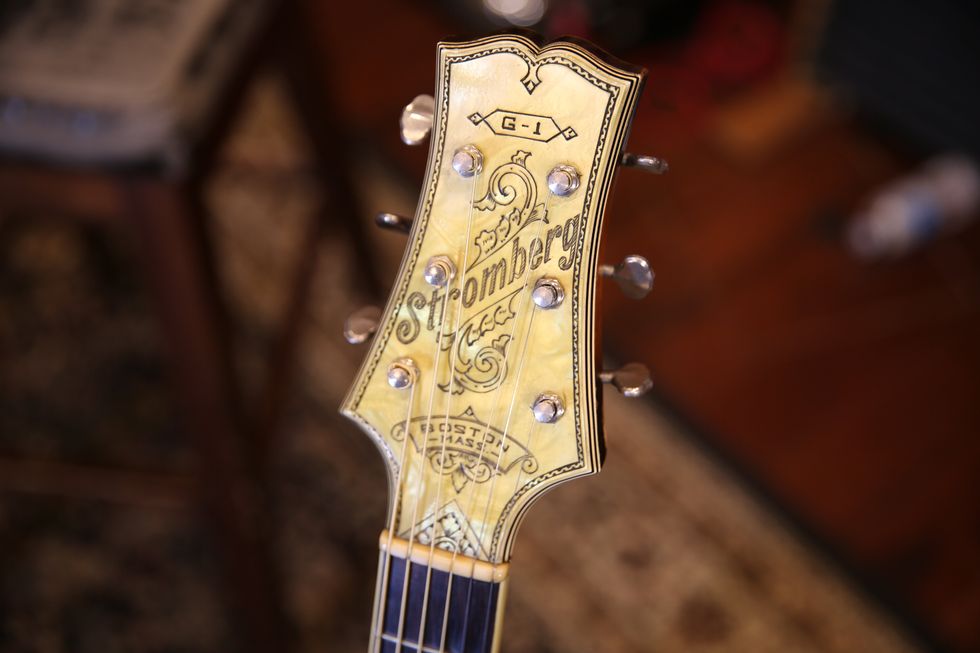
Here’s the headstock of the Stromberg that Mother Maybelle Carter used on the road while touring with Johnny Cash and her daughters. Her main guitar, dating back to the first recordings of country music, which she made as part of the Carter Family, was a Gibson L-5, but she judged this instrument hardier for travel.
Photos by Perry Bean
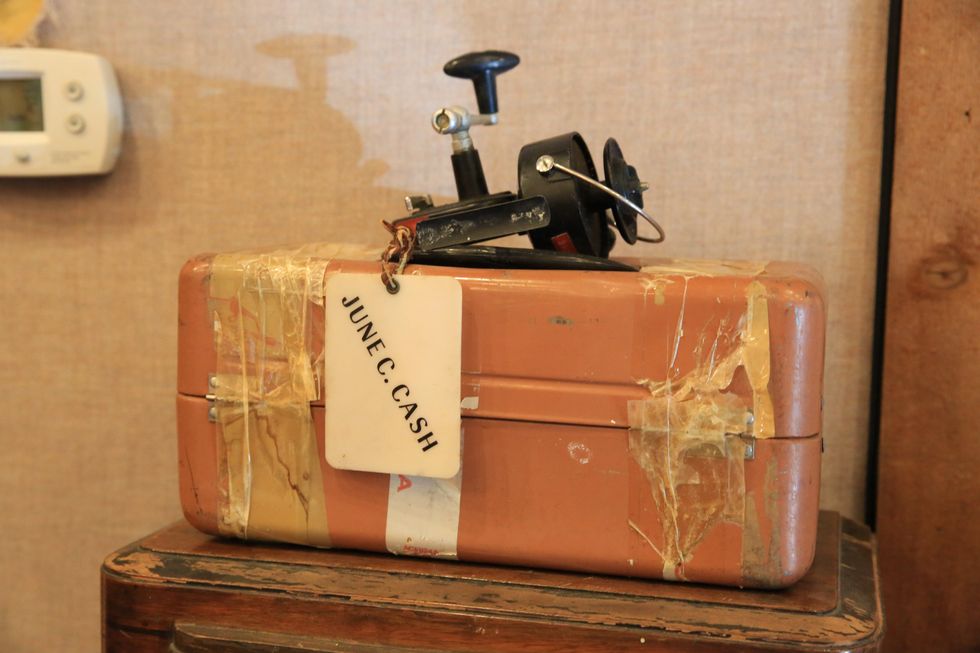
Fishing was a favorite pastime of the Cash family. This is June Carter Cash’s fishing reel and tackle box—one of the many personal and historic items in the cabin.
Photos by Perry Bean
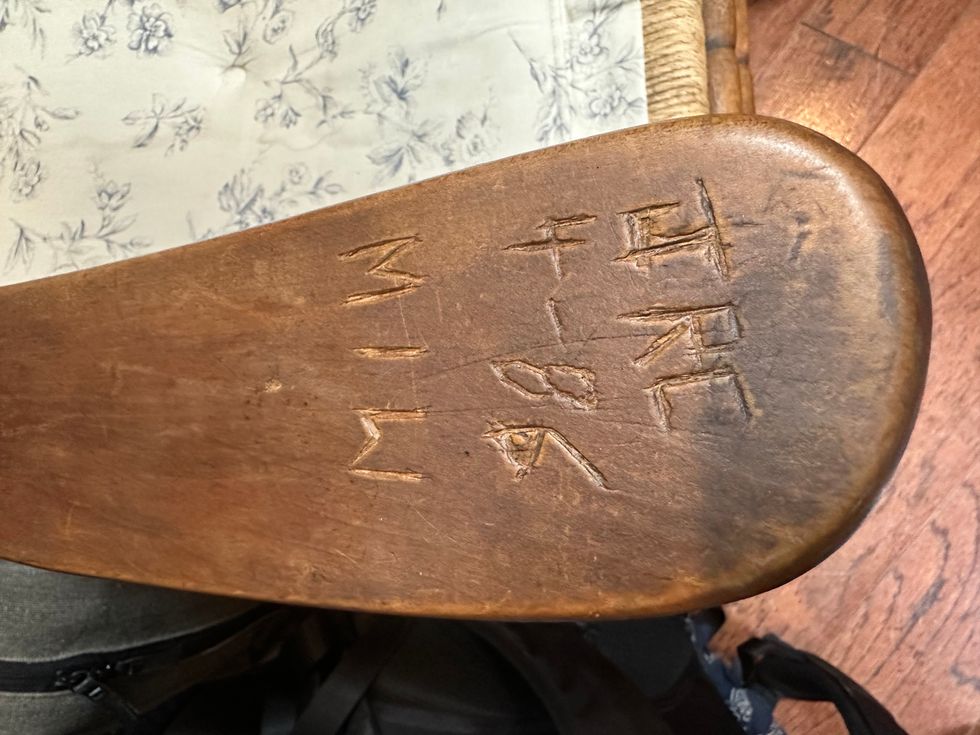
When Johnny Cash completed his novel about the apostle Paul, titled Man in White, he commemorated the occasion by scratching his initials and the day into the arm of the studio’s rocking chair—his favorite place to sit.
“In so many ways,” John Carter allows, “my father is always with me. People everywhere still love my father’s music. For instance, a 15-year-old kid wrote saying that without the strength through hardship my father expressed in his songs, he would not be alive. So, I think it’s important to support my father’s legacy in the world in which we live.
“My father made a distinction between the business of Johnny Cash and himself,” John Carter notes. “It’s almost like I’ve studied Johnny Cash my whole life, and so I can tie the two together somehow and still go through the healing process of losing a father while embracing him and his work on a level that spreads his music’s joy and brilliance to the world. I believe that his goal for his music and his life was to share with other people out there who connect on a level of the heart.” And that echoes, boldly, throughoutSongwriter.The new destination on Reverb will feature an always-changing collection of new and like-new music gear from top brands for at least 20% off retail prices.
“Outlet music gear is a fantastic value for music makers. Often, it’s brand new overstock or clearance music gear that retailers or brands are simply looking to clear out. Other times, it’s gear that’s been opened, used for a demo, or simply doesn’t have its original box, but is otherwise in like-new condition,” said Jim Tuerk, Reverb’s Director of Business Development. “With the launch of the Reverb Outlet, we’re making it easy to access your favorite brands for less.”
The Reverb Outlet will feature high-quality discounted music gear from Reverb’s community of authorized sellers, ranging from retailers like ProAudioStar and Alto Music to brands like Focusrite and Korg selling discounted items directly to music makers. All of the new and like-new music gear in The Reverb Outlet:
- Is at least 20% off retail prices—but often more
- Is sold by authorized retailers and brands
- Comes with free shipping, and
- Has a minimum 7-day return window.
“With economic pressures making it harder for music makers to invest in music gear, it’s more important than ever that the music-making community has access to affordable musical instruments. We launched the Reverb Outlet to make it easier for music makers to find the best deals on the instruments that will inspire them,” said Reverb CEO David Mandelbrot. “Now that players can shop discounted outlet music gear alongside our huge range of affordable used music gear, it’s easier than ever to find the perfect instrument for your budget.”
Visit the Reverb Outlet today and check back often, as new deals will be added regularly. Please note that as of now, this is available to those in the US only.
For more information, please visit reverb.com.
